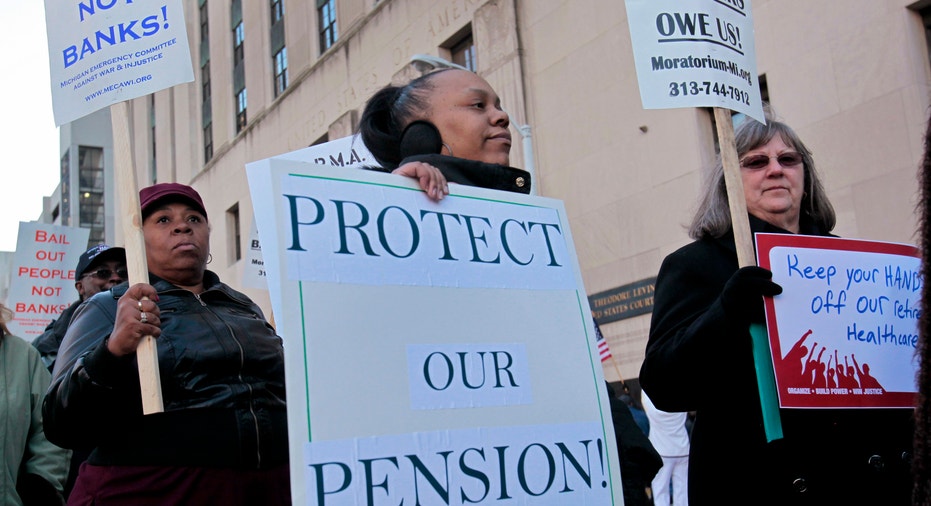Public Pension Funds Rethinking Investment Return Rates

Public officials charged with maintaining stable funding levels within their retiree pension systems are being forced to take a more conservative approach toward projected annual investment return rates.
Experts say it’s about time.
Consider the deal reached earlier this week between the bankrupt city of Detroit and groups representing the city’s retired firemen and police officers as part of Detroit’s ongoing efforts to restructure its $18 billion in debts.
After months of negotiations, the city agreed to set the projected investment return rate for those group’s pension funds at 6.75%. That means that the funds expect to see their investments increase by 6.75% each year.
In fact, the 6.75% rate was a concession on the part of the city’s negotiators who had wanted to set the rate even lower, possibly at 6.25% or 6.5%. They agreed to raise it apparently in part because of strong stock market returns in the past 18 months.
Still, the 6.75% figure is well below the 8% projection rate used by most public pension plans. But that’s changing.
“There is a general movement downward,” said James Spiotto, an expert in municipal finance and managing director at Chicago-based Chapman Strategic Advisors.
Controversial Return Rate Projections
A refresher: annual investment return rates are used to project the amount a pension fund will receive each year from its investments in stocks and bonds, which are usually managed through mutual funds and similar investment vehicles. The amount returned -- or earned -- is then used to cover the portion of the pension fund’s payouts to retirees not covered by tax revenue and employee contributions.
“If expectations were more realistic we wouldn’t be having these problems.”
Setting the rate has proved controversial over the years. Here’s why: theoretically, at least, the larger the projected return, the less taxpayers and public employees will be on the hook down the road for the covering the long-term costs of the pension.
For years, especially ahead of the 2008 financial crisis, elected officials and union leaders gravitated towards a higher number when projecting rates of return because it optimistically suggested that a healthy stock market and historically typical interest rates will cover a significant portion of the costs for funding retirees’ benefits -- 8% instead of, say, 6%.
In sum, when the numbers are projected higher it means -- again, theoretically -- that both taxpayers and the pensioners paying into the system have to contribute less to cover the costs of payouts. That’s a situation in which everyone -- politicians, union leaders, taxpayers and public employees -- all win.
Unless the stock market tanks as it did in 2008 and interest rates are slashed to historically low levels. Under that scenario it’s been very difficult for investment return rates to hit that 8% projection. And that’s led to a sharp rise in underfunded pension systems, or systems that don’t have enough assets to cover their future liabilities.
In its recent annual study of 134 state public pension systems, Wilshire Consulting found that 96% of them were underfunded.
“If expectations were more realistic we wouldn’t be having these problems,” said Michael Sweet, a bankruptcy attorney with Fox Rothschild in San Francisco. “The expectations aren’t in line with reality.”
Six Percent Assumptions Not “Outlandish”
More than five years after the worst of financial crisis, 10-year U.S. Treasury bonds are earning between 2% and 3%, and corporate bonds are returning a slightly higher 4% or 5%. Meanwhile, stock markets remain volatile despite surging last year. (“Who knows on stocks?” said Spiotto).
Pension funds are typically divided about 65% into stocks investments and 35% into bonds.
Given the low rates of return in bond markets and the enduring unpredictability of stock markets, it makes sense that an increasing number of pension fund administrators are setting their rate return assumptions lower. Projections around 6% “do not sound outlandish,” said Spiotto. “And that should be adjusted if they don’t achieve it over time.”
Detroit officials were hardly the first pension fund administrators to lower their projections.
Before adopting sweeping new pension reform legislation in 2011, the state of Rhode Island lowered its projected rate of return from 8.25% to 7.5%. Overall in 2010 and 2011, in the immediate wake of the Great Recession, 18 public pension plans in 14 states lowered their return assumptions, according to the Pew Center on the States.
In a 2013 study of 126 public pension plans, the National Association of State Retirement Administrators found that more than half have reduced their return assumption since 2008. The study found that while 8% remains “the predominant rate assumption,” the average has dropped to 7.72%.
When the projections are too high and the assumptions aren’t met, someone has to cover the shortfall down the road. The gap can be covered either through higher taxes, by using funds diverted away from other municipal services or by reducing benefits promised to retirees.
Under any of those circumstances there are no winners.
“Unfortunate” Discussion
Sweet said the damage that results when projections don’t meet expectations is that it ends up pitting different constituents against each other – retirees vs taxpayers, for example. Moreover, it can lead to cutbacks in needed municipal services and ultimately force retirees, many of them living on fixed incomes, to give back some of the benefits contractually granted to them.
“The whole discussion is unfortunate,” he said.
All of this is happening in Detroit.
Sweet said the current problems facing many public pension funds could have been avoided. Pension fund administrators, elected officials and union leaders created the difficulties by taking “what should be a very conservative – hyper-conservative -- investment and putting aggressive expectations on its returns,” he said.
The trend toward lower return rate projections is a positive sign, he said. “It’s certainly moving in the right direction.”



















